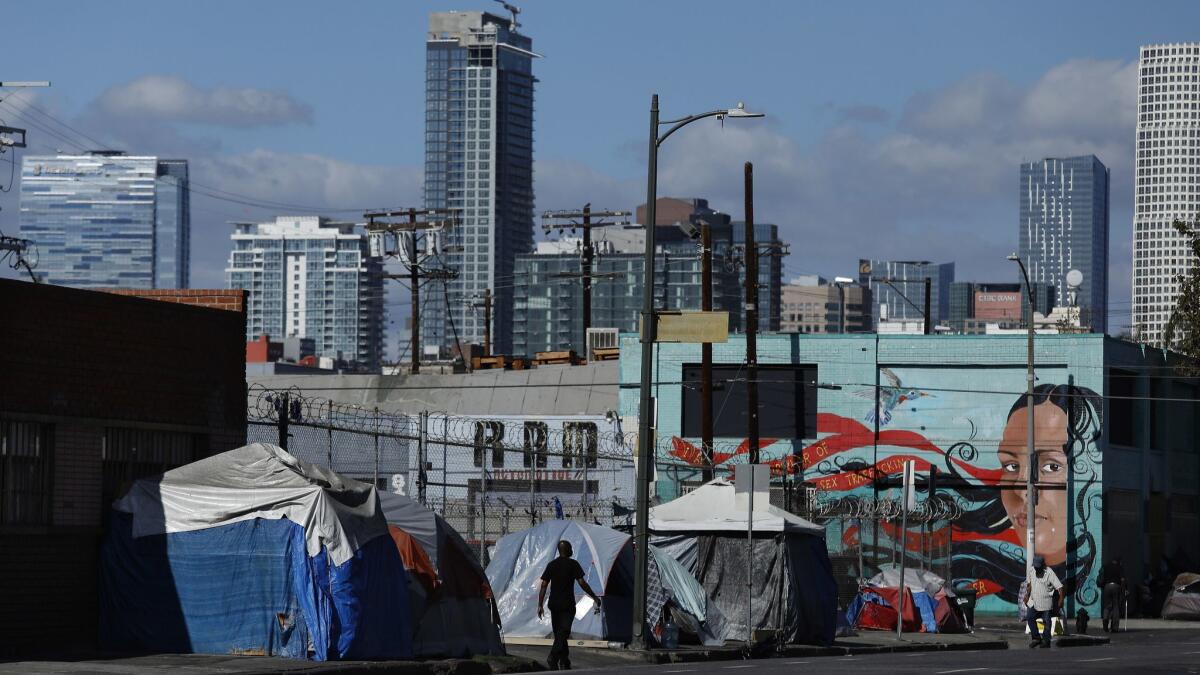Editorial: The sooner we build housing for homeless people, the sooner they can get off the sidewalk

- Share via
Building housing is a long, slow affair. It’s even slower when developers are building housing for homeless people. Just cobbling together financing from myriad sources can take up to two years, and then there’s the permitting, the political haggling, the inevitable negotiations with neighbors. So it’s encouraging to see two different attempts to speed up this lumbering process.
The U.S. Department of Veterans Affairs, which has created an ambitious plan for revamping its West L.A. campus and building or renovating 1,200 units of housing for homeless vets, announced that it has hired a principal developer to oversee the rollout. A group of three development firms has formed a company to take charge of the project, work with the community and oversee the other developers who will be hired to build the housing. The principal developer’s job is to set a brisk pace and keep the project moving — although in this case, a brisk pace may be wishful thinking. This is a huge task; the VA is essentially building a new town on its grounds. But the principal developer must, at the very least, keep the project from derailing.
Meanwhile, the L.A. city advisory committee on Proposition HHH, which weighs in on which homeless housing projects should be funded by the $1.2-billion bond issue authorized by the proposition, has offered city officials a plan to get those housing projects done faster and cheaper.
The committee proposes creating a pilot program to fast-track 1,000 units of HHH-funded housing.
Led by Miguel Santana, the former city administrative officer who was the architect of the city’s strategy to combat homelessness, the Citizens Oversight Committee has made no secret of its frustration with the slow pace of project approvals and the alarming rise in costs. At the rate the city is going, HHH will fall far short of producing the promised 10,000 units of housing in 10 years.
The committee proposes creating a pilot program to fast-track 1,000 units of HHH-funded housing. If the pilot works as hoped, the city should extend it.
A team of city bureaucrats would expedite the permitting process for those units. The city would look for developers whose projects include innovative construction techniques, such as modular housing, which is cheaper and faster to build. The developers would be encouraged to skip the drawn-out, requirement-laden process of getting federal tax credits.
In tandem with that, the city would remove the requirement that projects receive funding from multiple sources. Instead, projects in the pilot program would be able to obtain 100% of their funding from HHH.
Enter the Fray: First takes on the news of the minute from L.A. Times Opinion »
That last proposal sounds like a scary prospect for a fund that is in danger of being exhausted before the city has built anywhere near enough housing. But the rationale is that projects that get funded faster get built faster and don’t go over budget, so developers don’t return to the city to ask for more HHH money — as some are doing now. This would be an experiment, and if it doesn’t work, it wouldn’t be continued. But Mayor Eric Garcetti and the City Council — which will decide whether to implement the plan — should still consider limiting how much of the $1.2 billion in HHH funding that any one project could draw down.
What this plan would not do is force council members to live up to their pledge to help develop 222 units of homeless housing in each of their districts. Some have gotten off to a good start on this; others have not, insisting that there is little city land that could feasibly be made available in their districts to developers.
The advisory committee may have come up with a way to nudge council members in the right direction, however. The committee’s plan includes directing city workers to compile a list of available land owned by the city, county or state — and make it public. At the very least, the list would help reveal when council members were overlooking potential sites in their sluggish response to this crisis on their districts’ streets.
Follow the Opinion section on Twitter @latimesopinion or Facebook
More to Read
A cure for the common opinion
Get thought-provoking perspectives with our weekly newsletter.
You may occasionally receive promotional content from the Los Angeles Times.









